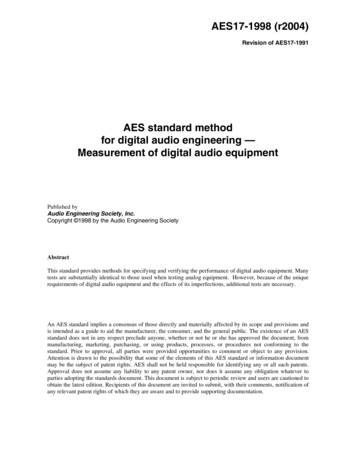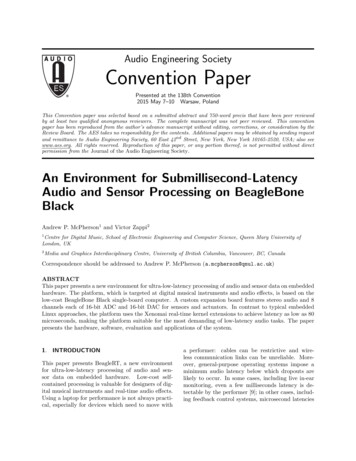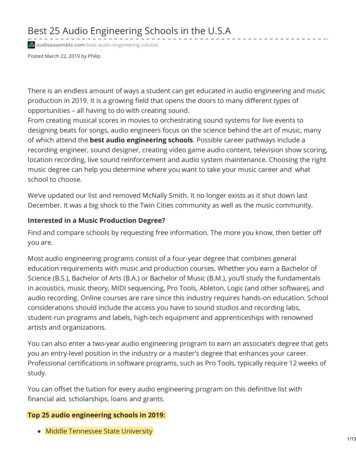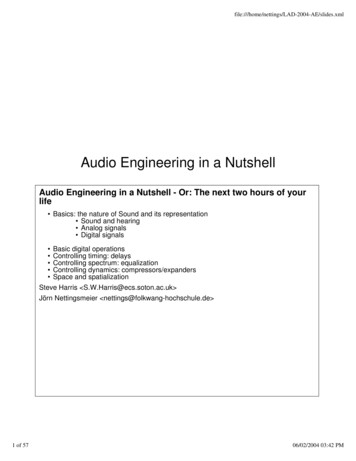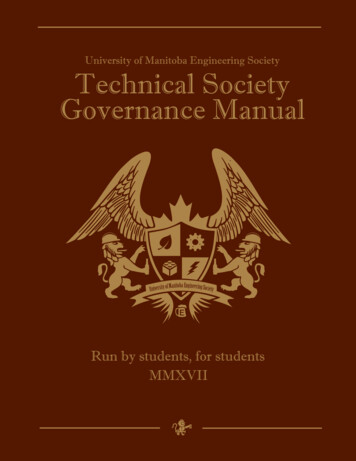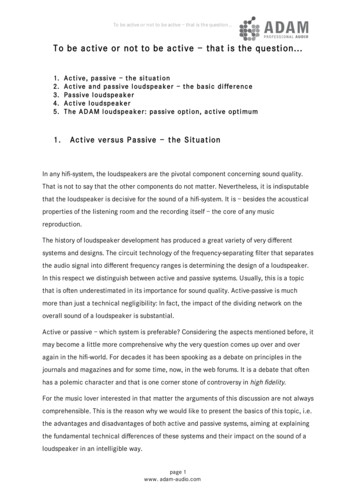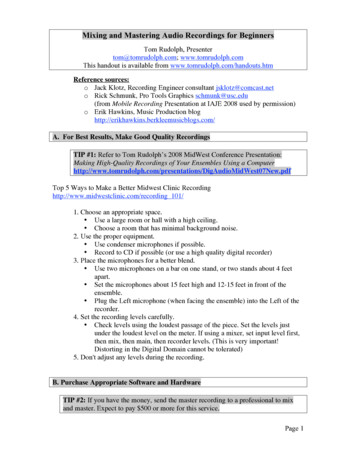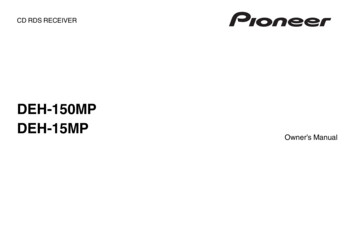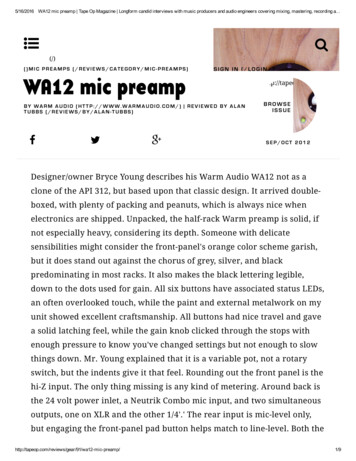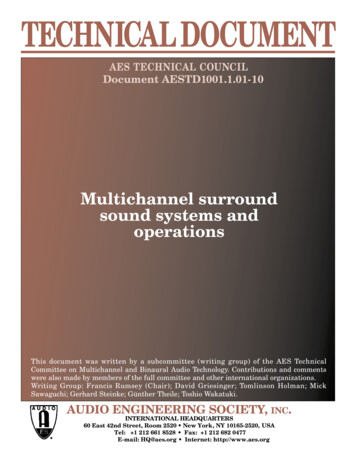
Transcription
TECHNICAL DOCUMENTAES TECHNICAL COUNCILDocument AESTD1001.1.01-10Multichannel surroundsound systems andoperationsThis document was written by a subcommittee (writing group) of the AES TechnicalCommittee on Multichannel and Binaural Audio Technology. Contributions and commentswere also made by members of the full committee and other international organizations.Writing Group: Francis Rumsey (Chair); David Griesinger; Tomlinson Holman; MickSawaguchi; Gerhard Steinke; Günther Theile; Toshio Wakatuki.AUDIO ENGINEERING SOCIETY, INC.INTERNATIONAL HEADQUARTERS60 East 42nd Street, Room 2520 New York, NY 10165-2520, USATel: 1 212 661 8528 Fax: 1 212 682 0477E-mail: HQ@aes.org Internet: http://www.aes.org.
AUDIO ENGINEERING SOCIETY, INC.INTERNATIONAL HEADQUARTERS60 East 42nd Street, Room 2520, New York, NY 10165-2520, USATel: 1 212 661 8528Fax: 1 212 682 0477E-mail: HQ@aes.orgInternet: http://www.aes.org.Europe ServicesB.P. 50, FR-94364 Bry Sur Marne Cedex, FranceTel: 33 1 4881 4632, Fax: 33 1 4706 0648E-mail for membership and publication sales: euroservices@aes.orgUnited KingdomBritish Section, Audio Engineering Society Ltd.P. O. Box 645, Slough, SL1 8BJ UKTel: 44 1628 663725, Fax: 44 1628 667002E-mail: UK@aes.orgJapanAES Japan Section1-38-2 Yoyogi, Room 703, Shibuyaku-ku,Tokyo 151-0053, JapanTel: 81 3 5358 7320, Fax: 81 3 5358 7328,E-mail: japan@aes.org
Neither AES nor any of its Committees or members shall be responsible for any consequencesresulting from the use of information contained in this publication.
AUDIO ENGINEERING SOCIETY, INC.INTERNATIONAL HEADQUARTERS60 East 42nd Street, Room 2520, New York, NY 10165-2520, USATel: 1 212 661 8528Fax: 1 212 682 0477E-mail: HQ@aes.orgInternet: http://www.aes.org.The Audio Engineering Society’s Technical Council and its Technical Committees respond tothe interests of the membership by providing technical information at an appropriate level viaconferences, conventions, workshops, and publications. They work on developing tutorialinformation of practical use to the members and concentrate on tracking and reporting the verylatest advances in technology and applications. This activity is under the direction of the AESTechnical Council and its Committees.The Technical Council and its first Technical Committees were founded by the AudioEngineering Society in 1979, and standing rules covering their activities were established in1986, with the intention of defining and consolidating the technical leadership of the Society forthe benefit of the membership. The Technical Council consists of the officers of the TechnicalCouncil, the chairs of the Technical Committees, the editor of the Journal, and as ex-officiomembers without vote, the other officers of the Society.TECHNICAL COUNCILWieslaw Woszczyk - Chair (WVW@AES.ORG)Juergen Herre - Vice Chair (HRR@AES.ORG)Robert Schulein - Vice Chair (RBS@AES.ORG)TECHNICAL COMMITTEESAcoustics & Sound ReinforcementArchiving, Restoration and Digital LibrariesAudio CodingAutomotive AudioHigh-Resolution AudioLoudspeakers & HeadphonesMicrophones & ApplicationsMultichannel & Binaural Audio TechnologiesNetwork Audio SystemsOptical RecordingPerception & Subjective Evaluation of Audio SignalsSignal ProcessingStudio Practices & ProductionTransmission & BroadcastingAES TC TECHNICAL PUBLICATIONSAES White Paper 1001: Networking Audio and Music Using Internet2and Next-Generation Internet CapabilitiesThis and other Technical Council publications may be downloaded from its home page at:WWW.AES.ORG/TechnicalThe Audio Engineering Society, now in its fifth decade, is the only professional society devotedexclusively to audio technology. Its membership of leading engineers, scientists, and otherauthorities has increased dramatically throughout the world, greatly boosting the Society’sstature and that of its members in a truly symbiotic relationship.Purpose: The Audio Engineering Society is organized for the purpose of uniting persons performingprofessional services in the audio engineering field and its allied arts; collecting, collating, anddisseminating scientific knowledge in the field of audio engineering and its allied arts; advancingsuch science in both theoretical and practical applications; and preparing, publishing, anddistributing literature and periodicals relative to the foregoing purposes and policies.Membership: Individuals who are interested in audio engineering may become members of theAES and Sustaining Memberships are available to persons, corporations, or organizations whowish to support the Society. A subscription to the Journal is included with all memberships.Publications and Events: The AES publishes a Journal, Convention Papers, Conference Proceedings, Standards, Information Documents, and Technical Documents, and organizes two InternationalConventions per year and numerous International Conferences on late-breaking audio topics.For membership applications, dues information, publications sales, and details on conventionsand conferences, contact any AES office or go to the AES website at www.aes.org
Technical Document AESTD1001.0.01-05Multichannel surround sound systemsand operations1 Background .22 Introduction to 3/2- or 5.1-channel stereo.23 Hierarchy of compatible multichannel sound systems for broadcasting and recording .34 Reference configuration.45 Low-frequency extension .55.1LFE signal and channel .55.2Separate low-frequency loudspeakers (subwoofers) within the standard configuration.65.3Considerations regarding the channel allocation of low-frequency program content .76 Monitoring environments.76.1Listening conditions—general notes .76.2Parameters and values for reference listening conditions.86.2.1 Suggestions for reference listening room (Table 1) .86.2.2 Suggestions for reference sound field at listening position (Table 2) .96.2.3 Background noise.116.2.4 Suggestions for reference monitor loudspeakers.126.3Alternative conditions for multichannel mixing rooms.137 Program interchange .177.1Track allocation in an eight-channel recording format (Table 5) .187.2Recording Levels .187.2.1 Recording levels in film sound.187.3Alignment signals .197.4Reproduction system alignment.19Page deleted September 2001.2 08 On the discrimination of reproduction formats and coding formats .219 References .22AES TC-MBAT Information Document: Multichannel Surround Sound Systems and Operations.
Technical Document AESTD1001.0.01-05Multichannel surround sound systemsand operations1BACKGROUNDThis document, issued by the AES Technical Committee on Multichannel and Binaural AudioTechnology, is intended to report developing practices concerning the configuration and use ofmultichannel surround sound systems based on the 3/2- or 5.1-channel model described in ITU-RBS.775-1 [1]. It is intended to acquaint studios with these developments, but it should also beuseful, to a large extent, for consumer equipment. It is not an AES standard or informationdocument and has not been subject to AES due process to determine a consensus on its content.However, it aims to summarize some of the most important features of existing internationalstandards relating to multichannel sound recording and reproduction, as well as to report goodpractice based on contributions from expert members of the AES and other international groups.While there will always be debate over what constitutes good practice in recording andreproduction, the Technical Council believes that one of its important functions is to convey thecurrent views of its members and to educate the audio industry at large. Consequently thisdocument represents the committee’s best attempt at describing the current state of the art, and maybe open to revision, resulting in further versions as new knowledge becomes available. In somecases, where international standards are clear about the way in which systems should be set up orused, and where little disagreement exists, this information has been related directly. (Thedocument is intentionally biased toward an acceptance of existing AES, ITU, EBU, and SMPTEstandards where they exist.) Where there is more uncertainty, or where standards lag evolvingindustry practice, the differing approaches have been described so that the reader is aware ofalternative points of view.The committee welcomes additional input, corrections, and proposed content for this document.Correspondence details are provided at the end of the document.2INTRODUCTION TO 3/2- OR 5.1-CHANNEL STEREOAlthough multichannel stereophony is not limited to a specific number of channels in principle,international agreement was reached some years ago on a configuration that represented acompromise between the need for optimum spatial enhancement of reproduction and the need foran approach that was practicable and compatible with conventional two-channel reproduction. Thesolution has become known colloquially as “5.1-channel” reproduction owing to its use of fivefull-bandwidth channels plus an optional, limited-bandwidth, low-frequency-extension (LFE)channel (the “0.1” channel). It has its origins in configurations designed for film soundreproduction where a center “dialogue” channel is considered of prime importance. In order tomaintain compatibility between the reproduction of film sound in the cinema or home and othertypes of surround sound program material, the same configuration was adopted for allapplications.2AES TC-MBAT Information Document: Multichannel Surround Sound Systems and Operations.
The standard configuration is also referred to as “3/2 stereo,” in recognition of the position of thisconfiguration in a hierarchy of multichannel stereo systems ranging from mono to many channels.In this hierarchy, a distinction is made between the number of front channels and the number ofrear/side “effects,” “surround,” “room impression” or “ambience” channels. (The designation 3/2therefore refers to the use of three front channels—left, center, right—and two rear/sidechannels—left surround and right surround. This is described further in the following, noting thatthe 3/2 format can also be extended to accommodate an LFE channel.)3HIERARCHY OF COMPATIBLE MULTICHANNELBROADCASTING AND RECORDINGSOUNDSYSTEMSFORThe 3/2 system is embedded within a hierarchy of multichannel sound formats. For such ahierarchy, down compatible as far as the monophonic format, simple matrixing conditions aregiven in [1] for the addition of partial signals at the transmission and storage or reproductionstages of a signal chain, facilitating basic intercompatibility between channel formats. (It is notedthat the compatibility matrixing approaches recommended in [1] are relatively crude, involving thesimple folding down of the rear channels and the center channel into the front channels with agiven level of attenuation. Alternative approaches to the downmixing of multichannel stereo totwo-channel stereo may be more subjectively satisfactory.)3/1-matrix formats (three frontal signals, one surround signal) are integrated in the hierarchy andmay be reproduced with the 3/2 configuration, in which case the monophonic surround signalfeeds the two surround loudspeakers and the gain of the surround channels is reduced by 3 dB.Japan accepted the 3/1 format within the ITU standard as an exception because it is used in Japanwith the MUSE transmission system.Systems with more channels than the 3/2 format are possible and can be matched—such as, 5/2,5/4, and so on. These formats are not included within the ITU standard and are not recommendedfor material intended to be reproduced under home conditions. The format with five frontalloudspeakers is used in the film domain under certain circumstances (and is an option for theDVD), but it should be produced in such a way that it is also down compatible with the 3/2 and 2/0formats.For all the other possible format combinations the reference configuration has to be the basis (seelater). Further loudspeakers can be attached to the reference configuration, but with the samenumber of sour
AUDIO ENGINEERING SOCIETY, INC. INTERNATIONAL HEADQUARTERS 60 East 42nd Street, Room 2520 . New York, NY 10165-2520, USA Tel: 1 212 661 8528. Fax: 1 212 682 0477 E-mail: HQ@aes.org. Internet: http://www.aes.org AES TECHNICAL COUNCIL Multichannel surround sound systems and operations
